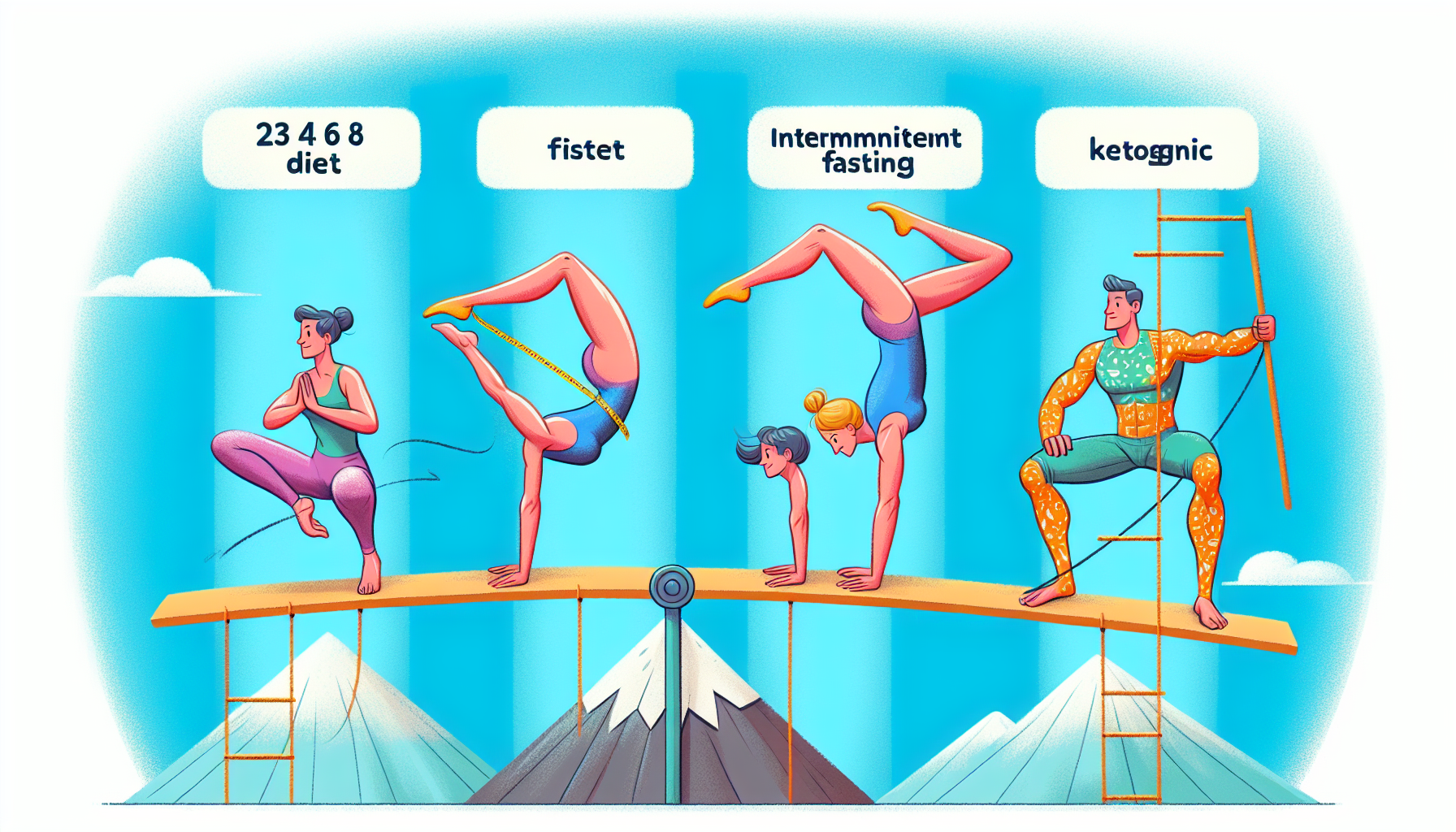Quick Links
The 2 4 6 8 diet cycles your calorie intake over four days—from 200 to 800 calories. Is it effective for weight loss? This article breaks down how it works, the benefits, and the risks involved.
Key Takeaways
- The 2 4 6 8 diet involves a cyclical calorie intake pattern, starting with 200 calories on day one and increasing to 800 calories on day four, before repeating the cycle.
- The diet promises quick weight loss and improved eating discipline, but potential risks include nutritional deficiencies and the development of eating disorders.
- Certain individuals, such as pregnant or breastfeeding women and those with specific medical conditions, should avoid the 2 4 6 8 diet due to its stringent calorie restrictions.
Introduction
Not so many years ago, diets focused on the simplicity of calorie counting and the rigidity of meal plans. Today, a new player enters the arena—the 2 4 6 8 diet. This dietary plan tempts with its structured yet unconventional pattern:
- 200 calories on day one
- 400 on day two
- 600 on the third
- 800 on the fourth
Exploring the intricacies of this diet will provide insights into its benefits, meal planning techniques, and key success strategies.
However, like any diet, potential risks exist, and it’s important to be mindful of who should avoid this calorie-cycling challenge.
Understanding the 2 4 6 8 Diet

The 2 4 6 8 diet is more than a numerical sequence; it’s a precise formula designed to challenge and change your eating patterns. At its core, the diet employs a cycling method of food intake, purportedly aimed at rapid weight loss and the cultivation of a balanced diet. But before diving headlong into this regimen, know that despite its allure, there is no concrete evidence that this diet yields the desired results.
Still, the concept of the 4 6 8 diet has sparked widespread interest, thus becoming a hot topic in diet discussions.
How the 2 4 6 8 Diet Works
Exploring the mechanics of the 2 4 6 8 diet uncovers a simple, yet challenging regimen. The process is cyclical, with the following “calories a day” intake each day:
- Day 1: 200 calories
- Day 2: 400 calories
- Day 3: 600 calories
- Day 4: 800 calories
After this crescendo of caloric intake, the cycle recommences, plummeting back to 200 calories.
This pattern is believed to boost metabolism and break through stubborn weight-loss plateaus, offering a glimmer of hope to those seemingly trapped in a cycle of dieting despair.
Creating a Meal Plan for the 2 4 6 8 Diet

Embarking on the 2 4 6 8 diet requires crafting a meal plan in the same way as painting on a restricted canvas—every calorie, much like every brushstroke, should be intentional and nutrient-rich. Emphasizing a balanced diet, the meal plan should be laden with whole grains, lean proteins, and healthy fats, all while shunning the empty calories of added sugars and saturated fats.
The challenge lies not only in adhering to the daily calorie limits but in ensuring that each morsel contributes to your overall health and well-being, helping you to practice healthy eating and eat healthy.
Sample meal ideas
Visualize starting your day with a breakfast of low-fat Greek yogurt, dotted with fresh raspberries and a sprinkle of crunchy walnuts—a nutritious ensemble that respects the calorie confines of this diet. As noon approaches, a vibrant White Bean & Veggie Salad awaits, followed by an evening meal of succulent Sheet-Pan Roasted Salmon & Vegetables. These sample meal ideas offer a glimpse into the variety and satisfaction possible within the diet’s strictures, guiding you through each given day without falling into monotony or hunger.
Foods to include
The food intake on the 2 4 6 8 diet includes a carefully curated gallery of nutritional excellence. Imagine your plate as a colorful canvas of:
- spinach
- eggs
- raspberries
- chickpeas
- succulent salmon
All chosen for their high nutrient density, these ingredients make up a healthy breakfast. Brown rice and whole grains like quinoa stand as the sturdy base, while Greek yogurt and blueberries add a burst of protein and antioxidants.
Walnuts and Brussels sprouts contribute healthy fats and texture, ensuring that every calorie not only fuels the body but also pleases the palate.
Foods to avoid
Yet, as some foods nourish, others hinder. On the 2 4 6 8 diet, it’s vital to pinpoint the foods that can derail your journey. Ultra-processed concoctions, sugary drinks, and that siren call of junk food must be staunchly avoided.
Foods heavy with added sugars, sodium, and saturated fats are not your allies in this challenge. Choosing to stop eating these unhealthy options is a crucial step in making the diet effective and maintaining the integrity of your calorie-controlled regimen.
Benefits of the 2 4 6 8 Diet

The appeal of the 2 4 6 8 diet is well-founded, as its advocates assert its potential for prompt weight loss and establishing a renewed sense of dietary control. The diet’s rhythmic variation in daily calorie intake is said to keep the metabolism on its toes, eager to burn fat and break free from the sluggishness of a weight loss plateau.
While rapid weight loss is an enticing benefit, improving eating discipline is another compelling draw, as the diet’s regimen instills a sense of order and mindfulness around food consumption.
- Quick weight loss
For anyone looking to lose weight, the 2 4 6 8 diet’s promise of swift results is like a beacon in the fog of weight loss confusion. By adhering to a calorie cycle of 200, 400, 600, and 800, the body is forced into a significant calorie deficit, a necessity for shedding pounds quickly. This regimented approach, underpinned by the principles of intermittent fasting, keeps dieters engaged and driven, potentially making the arduous journey of losing weight a more attainable and motivating endeavor.
- Improved eating discipline
But weight loss is not the only triumph; the 2 4 6 8 diet also acts as a stern teacher of discipline. Each day’s strict calorie limit serves as a lesson in control, urging dieters to plan meals meticulously and resist the temptation of impulsive snacking. Such structure necessitates mindfulness, encouraging individuals to fully understand the nature of hunger and become attuned to their body’s satiety signals.
This diet not only reduces waistlines but also enhances one’s capacity for disciplined living.
Potential Risks and Downsides

Despite its advantages, the 2 4 6 8 diet also has its disadvantages. The drastic reduction in calorie intake can lead to nutritional deficiencies, leaving the body starved of the vital nutrients it requires for optimal function. Moreover, the diet’s very strict diet nature may pave the way for eating disorders—an insidious risk that must not be overlooked.
And while weight loss may come quickly, it can be fleeting, as many dieters experience a rebound in weight gain once they resume a normal diet, a testament to the body’s adaptive resilience.
- Nutritional deficiencies
The low-calorie nature of the 2 4 6 8 diet inevitably raises concerns about nutritional sufficiency. Without a well-formulated plan that includes a variety of nutrient-dense foods, the body may suffer from a lack of essential vitamins and minerals. Such deficiencies can manifest in fatigue, weakness, and a weakened immune system—all of which are counterproductive to the pursuit of health and vitality.
This serves as a strong reminder that while restricting calories is possible, compromising nutrition is not an option.
- Eating disorders
The diet’s strict regimen, including the fasting period, can be a slippery slope, potentially leading to an eating disorder. For those with a history of eating disorders, the 2 4 6 8 diet could trigger harmful habits, such as excessive calorie restriction or binge eating. The intense focus on calorie counting and fasting can distort one’s relationship with food, obscuring the line between healthy discipline and unhealthy obsession.
Individuals must approach this diet cautiously, giving equal priority to their mental and emotional well-being as to their physical health.
- Weight gain rebound
The journey of weight loss on the 2 4 6 8 diet may be short-lived for some. Once the strict diet ends and normal eating resumes, a metabolic slowdown can lead to rapid weight gain, much to the frustration of those who have diligently counted every calorie. This rebound can be demoralizing, challenging the sustainability of such a restrictive diet.
This serves as a warning, emphasizing the need for a balanced approach to weight management that respects the body’s natural tendencies and values long-term health over transient success in achieving normal weight.
Tips for Success on the 2 4 6 8 Diet
Despite its challenges, achieving success on the 2 4 6 8 diet is possible with the appropriate strategies and mindset. It is crucial to stay hydrated, maintain balanced nutrition, and monitor progress. These pillars will not only aid in managing hunger but also ensure that the body receives the care it needs to thrive during this demanding dietary journey.
Here is some practical advice to help you safely and effectively navigate the 2 4 6 8 diet.
- Staying hydrated
Hydration is paramount on the 2 4 6 8 diet, serving as an oasis in the desert of calorie restriction. Water, the elixir of life, can stave off hunger pangs and aid in appetite control. Calorie-free beverages, such as herbal teas and black coffee, offer solace without compromising the diet’s rules.
Embracing these fluids is not just a strategy for success; it’s a commitment to honoring your body’s needs while sticking to the diet’s stringent demands.
- Balanced nutrition
Amidst the calorie counting, never lose sight of the importance of balanced nutrition. Each meal should be a harmonious symphony of vegetables, lean proteins, and whole grains, playing their parts to sustain energy and support muscle maintenance. It’s about making every calorie count, ensuring that even with limited quantities, your diet remains rich, varied, and fulfilling.
This philosophy not only fuels the body but also supports the mind, bolstering the resolve needed to adhere to the diet’s regimen.
- Monitoring progress
The path to success is paved with self-awareness, and maintaining a journal can be your compass. Documenting your meal choices and the physical changes you observe can be an invaluable source of motivation and insight. It’s a practice that fosters accountability, enabling you to celebrate your successes, learn from your missteps, and adjust your course as needed.
This record-keeping is not just about watching numbers on a scale; it’s about understanding the journey and appreciating the transformation.
Who Should Avoid the 2 4 6 8 Diet?
The 2 4 6 8 diet isn’t suitable for everyone. It is ill-advised for:
- Pregnant and breastfeeding women
- Individuals with certain medical conditions
- Those with weakened immune systems
- Those with bone health concerns
- Those with irregular menstrual cycles
- Those with gastrointestinal issues
The diet, with its stringent calorie limitations, could exacerbate existing health problems or create new ones.
This strongly emphasizes that the quest for weight loss should never overshadow overall health.
Comparing the 2 4 6 8 Diet to Other Popular Diets

When placed side by side with other popular diets, the 2 4 6 8 diet stands out for its regimented calorie cycling. Unlike the adaptability of intermittent fasting methods such as the 16/8 protocol, the 2 4 6 8 diet demands unwavering compliance to its structured calorie limits.
The ketogenic diet, with its focus on high-fat intake, contrasts sharply with the 2 4 6 8 diet’s emphasis on calorie control. Each diet has its unique philosophy and approach, and the best choice ultimately depends on an individual’s lifestyle, goals, and health considerations.
Summary
As we reach the end of our exploration, the 2 4 6 8 diet emerges as a regimented approach to weight loss and eating discipline, one that demands careful consideration and adherence. It’s a diet that offers the potential for rapid results but also carries with it the risk of nutritional deficiencies and the possibility of fostering eating disorders. Before embarking on this dietary journey, it’s essential to weigh the benefits against the potential downsides and consult with a healthcare professional if needed. Remember, the ultimate goal is not just to lose weight but to embrace a healthier, more balanced lifestyle.
Frequently Asked Questions
How exactly does the 2 4 6 8 diet intend to promote weight loss?
The 2 4 6 8 diet aims to promote weight loss by cycling through a structured pattern of caloric intake, starting at 200 calories and increasing by 200 calories each day until reaching 800 calories on the fourth day, and then repeating the cycle. This is intended to create a calorie deficit for rapid weight loss.
What are some of the potential risks associated with the 2 4 6 8 diet?
The 2 4 6 8 diet may lead to nutritional deficiencies, eating disorders, and weight gain rebound when returning to normal eating habits, potentially causing harm to your health. Be mindful of these potential risks before choosing to follow this diet.
Can I exercise while on the 2 4 6 8 diet?
Yes, you can exercise while on the 2 4 6 8 diet, but it’s best to stick to light exercises like yoga on fasting days to avoid low energy levels. Listen to your body and adjust your activity level accordingly.
Are there any groups of people who should avoid the 2 4 6 8 diet?
Yes, pregnant and breastfeeding women, individuals with medical conditions such as diabetes, and those with nutritional deficiencies or weakened immune systems should avoid the 2 4 6 8 diet.
How does the 2 4 6 8 diet compare to intermittent fasting methods like the 16/8 method?
Intermittent fasting, such as the 16/8 method, allows for more flexibility and adapts better to individual lifestyles compared to the structured approach of the 2 4 6 8 diet.
Ali Webster is a seasoned researcher, communicator, and Registered Dietitian with a diverse background encompassing government, nonprofits, academia, and health care. The core belief is that science should be made accessible, understandable, and relevant to all individuals, driving the motivation behind their work. Proficient in conducting and interpreting research to shape nutrition policy decisions, the individual also excels in nutrition and health communication, consumer research survey development and implementation, and clinical nutrition. Holding a Doctorate of Philosophy with a focus on Nutrition and Epidemiology from the University of Minnesota, their dietetic internship emphasized medical nutrition therapy.

